Input interpretation

N_2 nitrogen + F_2 fluorine ⟶ F_3N nitrogen trifluoride
Balanced equation
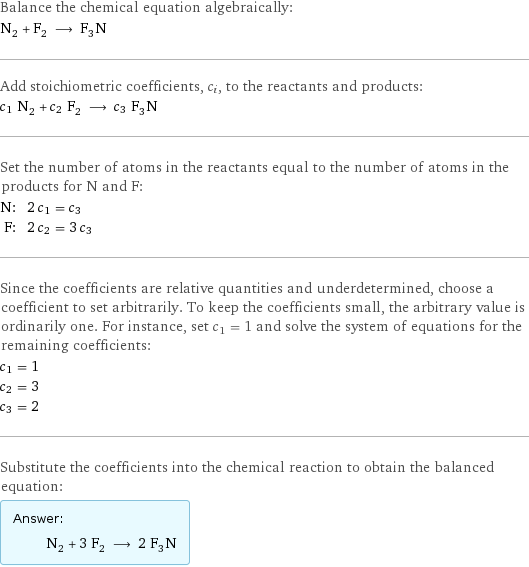
Balance the chemical equation algebraically: N_2 + F_2 ⟶ F_3N Add stoichiometric coefficients, c_i, to the reactants and products: c_1 N_2 + c_2 F_2 ⟶ c_3 F_3N Set the number of atoms in the reactants equal to the number of atoms in the products for N and F: N: | 2 c_1 = c_3 F: | 2 c_2 = 3 c_3 Since the coefficients are relative quantities and underdetermined, choose a coefficient to set arbitrarily. To keep the coefficients small, the arbitrary value is ordinarily one. For instance, set c_1 = 1 and solve the system of equations for the remaining coefficients: c_1 = 1 c_2 = 3 c_3 = 2 Substitute the coefficients into the chemical reaction to obtain the balanced equation: Answer: | | N_2 + 3 F_2 ⟶ 2 F_3N
Structures

+ ⟶
Names

nitrogen + fluorine ⟶ nitrogen trifluoride
Reaction thermodynamics
Enthalpy

| nitrogen | fluorine | nitrogen trifluoride molecular enthalpy | 0 kJ/mol | 0 kJ/mol | -132.1 kJ/mol total enthalpy | 0 kJ/mol | 0 kJ/mol | -264.2 kJ/mol | H_initial = 0 kJ/mol | | H_final = -264.2 kJ/mol ΔH_rxn^0 | -264.2 kJ/mol - 0 kJ/mol = -264.2 kJ/mol (exothermic) | |
Gibbs free energy
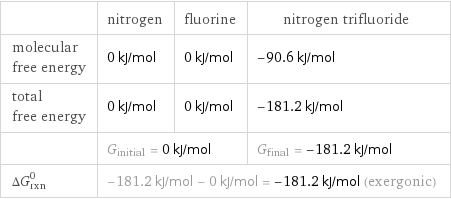
| nitrogen | fluorine | nitrogen trifluoride molecular free energy | 0 kJ/mol | 0 kJ/mol | -90.6 kJ/mol total free energy | 0 kJ/mol | 0 kJ/mol | -181.2 kJ/mol | G_initial = 0 kJ/mol | | G_final = -181.2 kJ/mol ΔG_rxn^0 | -181.2 kJ/mol - 0 kJ/mol = -181.2 kJ/mol (exergonic) | |
Entropy
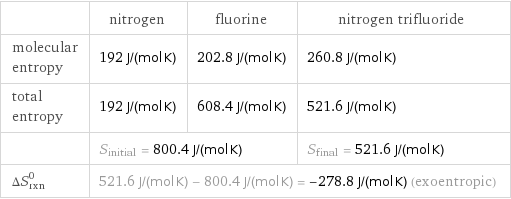
| nitrogen | fluorine | nitrogen trifluoride molecular entropy | 192 J/(mol K) | 202.8 J/(mol K) | 260.8 J/(mol K) total entropy | 192 J/(mol K) | 608.4 J/(mol K) | 521.6 J/(mol K) | S_initial = 800.4 J/(mol K) | | S_final = 521.6 J/(mol K) ΔS_rxn^0 | 521.6 J/(mol K) - 800.4 J/(mol K) = -278.8 J/(mol K) (exoentropic) | |
Equilibrium constant
![Construct the equilibrium constant, K, expression for: N_2 + F_2 ⟶ F_3N Plan: • Balance the chemical equation. • Determine the stoichiometric numbers. • Assemble the activity expression for each chemical species. • Use the activity expressions to build the equilibrium constant expression. Write the balanced chemical equation: N_2 + 3 F_2 ⟶ 2 F_3N Assign stoichiometric numbers, ν_i, using the stoichiometric coefficients, c_i, from the balanced chemical equation in the following manner: ν_i = -c_i for reactants and ν_i = c_i for products: chemical species | c_i | ν_i N_2 | 1 | -1 F_2 | 3 | -3 F_3N | 2 | 2 Assemble the activity expressions accounting for the state of matter and ν_i: chemical species | c_i | ν_i | activity expression N_2 | 1 | -1 | ([N2])^(-1) F_2 | 3 | -3 | ([F2])^(-3) F_3N | 2 | 2 | ([F3N])^2 The equilibrium constant symbol in the concentration basis is: K_c Mulitply the activity expressions to arrive at the K_c expression: Answer: | | K_c = ([N2])^(-1) ([F2])^(-3) ([F3N])^2 = ([F3N])^2/([N2] ([F2])^3)](../image_source/f5da9e35485634dc6fe0289d9bc3a9af.png)
Construct the equilibrium constant, K, expression for: N_2 + F_2 ⟶ F_3N Plan: • Balance the chemical equation. • Determine the stoichiometric numbers. • Assemble the activity expression for each chemical species. • Use the activity expressions to build the equilibrium constant expression. Write the balanced chemical equation: N_2 + 3 F_2 ⟶ 2 F_3N Assign stoichiometric numbers, ν_i, using the stoichiometric coefficients, c_i, from the balanced chemical equation in the following manner: ν_i = -c_i for reactants and ν_i = c_i for products: chemical species | c_i | ν_i N_2 | 1 | -1 F_2 | 3 | -3 F_3N | 2 | 2 Assemble the activity expressions accounting for the state of matter and ν_i: chemical species | c_i | ν_i | activity expression N_2 | 1 | -1 | ([N2])^(-1) F_2 | 3 | -3 | ([F2])^(-3) F_3N | 2 | 2 | ([F3N])^2 The equilibrium constant symbol in the concentration basis is: K_c Mulitply the activity expressions to arrive at the K_c expression: Answer: | | K_c = ([N2])^(-1) ([F2])^(-3) ([F3N])^2 = ([F3N])^2/([N2] ([F2])^3)
Rate of reaction
![Construct the rate of reaction expression for: N_2 + F_2 ⟶ F_3N Plan: • Balance the chemical equation. • Determine the stoichiometric numbers. • Assemble the rate term for each chemical species. • Write the rate of reaction expression. Write the balanced chemical equation: N_2 + 3 F_2 ⟶ 2 F_3N Assign stoichiometric numbers, ν_i, using the stoichiometric coefficients, c_i, from the balanced chemical equation in the following manner: ν_i = -c_i for reactants and ν_i = c_i for products: chemical species | c_i | ν_i N_2 | 1 | -1 F_2 | 3 | -3 F_3N | 2 | 2 The rate term for each chemical species, B_i, is 1/ν_i(Δ[B_i])/(Δt) where [B_i] is the amount concentration and t is time: chemical species | c_i | ν_i | rate term N_2 | 1 | -1 | -(Δ[N2])/(Δt) F_2 | 3 | -3 | -1/3 (Δ[F2])/(Δt) F_3N | 2 | 2 | 1/2 (Δ[F3N])/(Δt) (for infinitesimal rate of change, replace Δ with d) Set the rate terms equal to each other to arrive at the rate expression: Answer: | | rate = -(Δ[N2])/(Δt) = -1/3 (Δ[F2])/(Δt) = 1/2 (Δ[F3N])/(Δt) (assuming constant volume and no accumulation of intermediates or side products)](../image_source/00fee98aa93dd07de24c08bdfd6e5974.png)
Construct the rate of reaction expression for: N_2 + F_2 ⟶ F_3N Plan: • Balance the chemical equation. • Determine the stoichiometric numbers. • Assemble the rate term for each chemical species. • Write the rate of reaction expression. Write the balanced chemical equation: N_2 + 3 F_2 ⟶ 2 F_3N Assign stoichiometric numbers, ν_i, using the stoichiometric coefficients, c_i, from the balanced chemical equation in the following manner: ν_i = -c_i for reactants and ν_i = c_i for products: chemical species | c_i | ν_i N_2 | 1 | -1 F_2 | 3 | -3 F_3N | 2 | 2 The rate term for each chemical species, B_i, is 1/ν_i(Δ[B_i])/(Δt) where [B_i] is the amount concentration and t is time: chemical species | c_i | ν_i | rate term N_2 | 1 | -1 | -(Δ[N2])/(Δt) F_2 | 3 | -3 | -1/3 (Δ[F2])/(Δt) F_3N | 2 | 2 | 1/2 (Δ[F3N])/(Δt) (for infinitesimal rate of change, replace Δ with d) Set the rate terms equal to each other to arrive at the rate expression: Answer: | | rate = -(Δ[N2])/(Δt) = -1/3 (Δ[F2])/(Δt) = 1/2 (Δ[F3N])/(Δt) (assuming constant volume and no accumulation of intermediates or side products)
Chemical names and formulas
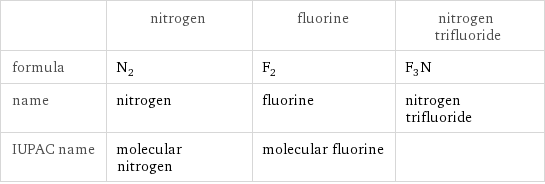
| nitrogen | fluorine | nitrogen trifluoride formula | N_2 | F_2 | F_3N name | nitrogen | fluorine | nitrogen trifluoride IUPAC name | molecular nitrogen | molecular fluorine |
Substance properties
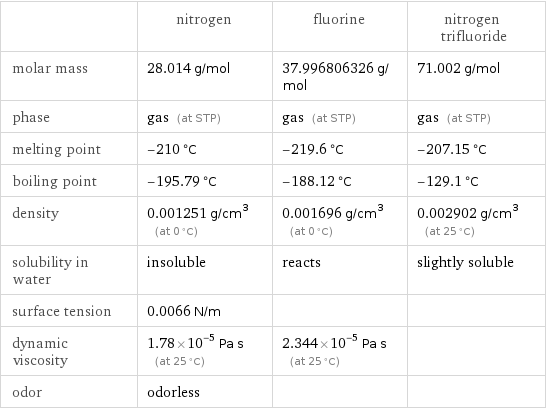
| nitrogen | fluorine | nitrogen trifluoride molar mass | 28.014 g/mol | 37.996806326 g/mol | 71.002 g/mol phase | gas (at STP) | gas (at STP) | gas (at STP) melting point | -210 °C | -219.6 °C | -207.15 °C boiling point | -195.79 °C | -188.12 °C | -129.1 °C density | 0.001251 g/cm^3 (at 0 °C) | 0.001696 g/cm^3 (at 0 °C) | 0.002902 g/cm^3 (at 25 °C) solubility in water | insoluble | reacts | slightly soluble surface tension | 0.0066 N/m | | dynamic viscosity | 1.78×10^-5 Pa s (at 25 °C) | 2.344×10^-5 Pa s (at 25 °C) | odor | odorless | |
Units
